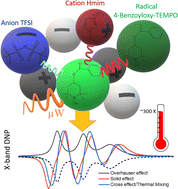Three mechanisms of room temperature dynamic nuclear polarization occur simultaneously in an ionic liquid†
Abstract
Dynamic nuclear polarization is a versatile approach to increasing the sensitivity of NMR measurements and is achieved by any of four different mechanisms which dominate for either liquids or solids, depending on temperature and radical density. In this work, we unequivocally demonstrate for the first time the coexistence, at a comparable magnitude, of several mechanisms, namely the Overhauser effect, solid effect, and cross-effect/thermal mixing in a viscous ionic liquid at ambient temperatures.



 Please wait while we load your content...
Please wait while we load your content...